Fargues-Saint-Hilaire, Gironde, Nouvelle-Aquitaine 作者: 来源: 发布时间:2021-09-22
I.Population and Area
Total Area: 7.02 km2
Population in 2017: 2 889
Population Density: 412 /km2
Histogram of demographic change
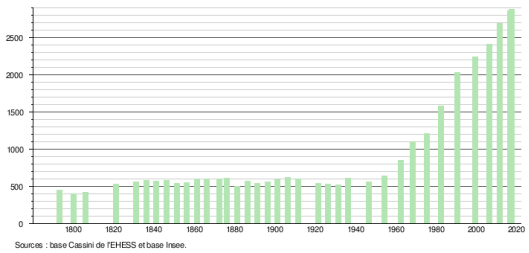
II.Natural Geography (environment and resources)
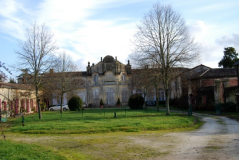
Fargues-Saint-Hilaire is a town in southwestern France, located in the Gironde department in the Nouvelle-Aquitaine region.
Fargues-Saint-Hilaire is a municipality in the urban area of Bordeaux and its urban unit, It is located in Entre-deux-Mers, on the departmental road 936, at the gates of the metropolis of Bordeaux. It is watered by Laurence which takes its source there.
Transposrt:
1)Carpooling:
In order to allow you to simplify your transport, the municipality of Fargues Saint-Hilaire engages in carpooling.
The Fargues Saint-Hilaire carpooling area is located at the back of the car park on the Place du Docteur Dejean next to the pharmacy.
GIRONDE COVOITURAGE: A FREE SERVICE
Also discover the “Carpooling Gironde” service to prepare your routes and find your travel partners.
2)Line 407 Creon Bordeaux
Since September 2, 2019, at the initiative of the Region, an experimental bus transport line has been in place.
It connects Créon to Bordeaux and passes through our town.
For more info www.transgironde.fr
Or www.bordeaux-metropole.fr/Actualites/Deplacements-une-nouvelle-liaison-Creon-Bordeaux
3)Regional trains
The Nouvelle-Aquitaine region, the transport organizing authority, informs you of the new regional train timetables in force since July 2, 2017 in connection with the entry into service of the Tours-Bordeaux High Speed Line.
You will find leaflets for all regional rail lines at the following internet address.
https://www.nouvelle-aquitaine.fr/dispositifs-region/nouveaux-horaires-ter-2017.html
4)TransGironde: Bus lines 402 and 404 serve our town.
Sources : http://www.fargues-saint-hilaire.fr/vie-pratique/transport/covoiturage
http://www.fargues-saint-hilaire.fr/vie-pratique/transport/ligne-407-creon-bordeaux
http://www.fargues-saint-hilaire.fr/vie-pratique/transport/trains-regionaux
http://www.fargues-saint-hilaire.fr/vie-pratique/transport/transgironde
III.Economy
Employment rate (%): 76.3 (2017)
Average employment income (€):2 632 net per month (31 584 net per year)(2014)
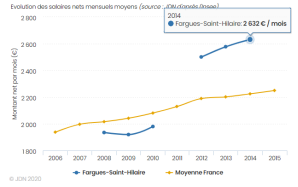
Evolution of average monthly net wages
Sources : http://www.journaldunet.com/business/salaire/fargues-saint-hilaire/ville-33165
https://insee.fr/fr/statistiques/2011101?geo=COM-33164#chiffre-cle-8
IV.Industrial Characterisitics
Sectors of activity most represented in Fargues-Saint-Hilaire
The table below lists the five activity sectors with the most companies in Fargues-Saint-Hilaire during the period from 09/24/2019 to 09/24/2020 as well as the share of each sector on the total number of businesses in the municipality.
Sector of activity | Number of companies | Share of companies |
Rental and operation of own or leased real estate | 167 | 30.0% |
Other human health activities | 25 | 4.5% |
Physicians and dentists activity | 21 | 3.8% |
Other personal services | 20 | 3.6% |
Activities of other membership organizations | 17 | 3.1% |
The companies that generate the most turnover in Fargues-Saint-Hilaire
The list displayed below presents the companies established in Fargues-Saint-Hilaire and which report the highest 2019 turnover in the municipality.
1)Residence Du Clos Lafitte
2)La Casa Italienne
Residence Du Clos Lafitte:
RESIDENCE DU CLOS LAFITTE, a simplified joint-stock company, has been in business for 26 years.
Based in FARGUES-SAINT-HILAIRE (33370), it is specialized in the sector of the activities of holding companies. Its workforce is between 50 and 99 employees.
In 2019, it achieved a turnover of 4,709,100.00 €.
The balance sheet total increased by 39.47% between 2018 and 2019.
Societe.com lists 6 establishments and 1 notable event over the past year.
DOMUSVI SAS is president of the RESIDENCE DU CLOS LAFITTE company.
La Casa Italienne:
LA CASA ITALIENNE, a limited liability company, has been active for 12 years.
Based in FARGUES-SAINT-HILAIRE (33370), it specializes in the traditional catering business sector. Its workforce is between 6 and 9 employees.
Over the year 2019 it achieves a turnover of € 469,500.00.
Societe.com lists 1 establishment and the last notable event of this company dates from 05-22-2017.
Olivier CASAMASSIMA, is manager of the company LA CASA ITALIENNE.
ECONOMIC POTENTIAL
The commune of Fargues Saint-Hilaire enjoys a favorable position on the Departmental Route 936, with extensive commercial activities and services which radiate beyond the commune and a natural landscape marked by the virtual absence of vine cultivation. .
Less than five kilometers from the Bordeaux bypass, Fargues-Saint-Hilaire offers a range of shops and services that cannot be found in the neighboring municipalities.
A "street" of shops and services
Less than five kilometers from the Bordeaux bypass, Fargues-Saint-Hilaire offers a range of shops and services that cannot be found in the equivalent in neighboring municipalities, nor in municipalities which are crossed by the RN 89. Only Latresne on the banks of the Garonne, the old bastide of Créon in the heart of Entre-deux-Mers or Branne on the same RD 936 road, when crossing the Dordogne, has such a rich potential. It is not the service offering that makes this set so unique. Indeed, in relation to the size of the population and especially its rapid growth since the 1980s, almost all municipalities have one or more medical practices, a pharmacy, real estate agents, insurers, banking agencies, personal services (hairdressers, beauticians)… Fargues-Saint-Hilaire adds an analysis laboratory and a law firm. The fairly diversified commercial potential, even though this sector is the most directly threatened by the supermarkets located on the outskirts of the Bordeaux metropolitan area, makes Fargues-Saint-Hilaire unique. The municipality has one store, sometimes two in all branches of the food trade.
Fargues-Saint-Hilaire has a supermarket, spreading over all the surrounding municipalities, set back a little from the main road, but ideally located on the edge of the future detour which will relieve the village of a large part of its traffic. The catchment area of this store is developing more towards the urbanizing rural heart of Entre-deux-Mers than towards the ring road where competition from hypermarkets is very strong. With the exception of the supermarket, all of the shops and services establishments stretch along the RD 936. The density of establishments is higher in the heart of the village, more dispersed at both ends of the urbanized core. The reality is somewhat different for at least two reasons: the avenue de l'Entre-deux-Mers, the name given to the RD 936, remains above all a road, with a regional vocation, more and more used; the occupation of this artery by shops and services seems singularly unorganized. In fact, there are shops which occupy the old building, depending on the openings at various times, and more recent locations in buildings combining retail and service spaces on the ground floor and apartments on the upper floors.
This state is the product of the history of this establishment. There has always been activity in the Bons Enfants district which took advantage of the traffic on the departmental road leading to Bergerac, from the tram stop that provided the journey to Camarsac. The demographic recovery after the Second World War made it possible to flesh out this embryonic nucleus. But at the same time, competition from supermarkets caused the decline of food businesses. During the 1980s, the municipality commissioned a study on the possibility of setting up a supermarket at the Bons Enfants crossroads. This attempt ended in failure. A little later, the installation of the supermarket in a location offering more possibilities due to better land holdings helped strengthen local commerce. In addition, elected officials have developed two real estate programs, one at the crossroads of Bons Enfants, the other at the crossroads of the Lignan road, where there are associated locations for shops and services and apartments. These achievements reinforce the vocation of Fargues-Saint-Hilaire but do not fundamentally modify the linearity of the development of activities and the lack of cohesion in their distribution.
Sources: http://entreprises.lefigaro.fr/fargues-saint-hilaire/ville-33165
http://www.fargues-saint-hilaire.fr/la-commune/mairie/presentation
V.Attractions
1. Sainte-Raphine Chapel
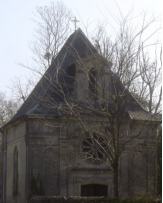
IDENTIFICATION
Chapel
Name: Private owner
Community of communes
Name: Community of communes of the Bordeaux hills
ARCHITECTURE AND ART
Architectural description
Access to the chapel being prohibited, it is impossible to describe the building.
Period and styles
XIXth
Main stages of construction
In 1692, the chapel is known to welcome pilgrims from the surrounding parishes who come on the day of the Holy Ruphine (and not Raphine according to the minutes). There is a popular devotional practice there: "a wall in front of the said altar open to the right and to the left by where the people pass to make their nine turns on the day of the making of Ste Ruphine and the Sunday after or there is a great competition of the people who give alms to the said chapel assés considerable "(AD, G 637, Fargues, 1692)
History and important dates
This chapel is given as old by an author but it has left no trace in the archives. It does not appear to be prior to the 19th century.
RELIGIOUS AND CULTURAL LIFE
Assignment / Usage
No worship
Other use: not specified.
Beauséjour Castle
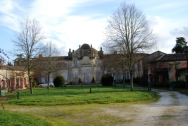
Address entered in the Mérimée database:
33370 Fargues-Saint-Hilaire - France
Insee code of the town: 33165
Gironde - Bordeaux - Aquitaine - New-Aquitaine
Approximate address from GPS coordinates (latitude and longitude):
94 Avenue de l'Entre-Deux Mers 33370 Fargues-Saint-Hilaire
Protected elements:
Facades and roofs of the house, the orangery and the north-eastern outbuilding overlooking the courtyard; wall on courtyard of the South-West dependency; Chapel ; interior decor of the home; entrance gate with its gate; portal overlooking the orangery; terrace with balusters, with its stairs and fountain (cad. B 920, 918): registration by decree of May 30, 1990
History:
Nothing remains of the first noble house, which already existed in the 17th century. The date of 1734 inscribed on the facades of the house, probably indicates the year of construction of the current building. The castle is made up of a set of buildings grouped around two courtyards, with outbuildings and agricultural buildings. Access to the main courtyard is via a gate framed by piles. At the end of the courtyard is the rectangular dwelling, the center of which is occupied by a cantilevered avant-corps surmounted by an attic. This building is one of the best examples of the Rococo style in Bordeaux.
Construction periods:
18th century, 19th century
Sources : https://www.patrimoine-religieux.fr/eglises_edifices/33-Gironde/33165-Fargues-Saint-Hilaire/174075-ChapelleSainte-Raphine
https://monumentum.fr/chateau-beausejour-pa00083874.html
VI.History
In the 1793 census there were 458 inhabitants in the town, the population grew slowly until 1954 (646 inhabitants), doubled in the mid-1960s, to be practically multiplied by 6 today (2,449 inhabitants). Fargues is the Gascon expression of French: forges, in ancient times iron craftsmanship characterized the town. The juxtaposition to the name Fargues of the saint to whom the parish was consecrated, allowed, in 1886, to differentiate Fargues-Saint-Hilaire from Fargues-de-Langon (Saint Hilaire was bishop of Poitiers in 353).
In the Middle Ages, there were two parishes on the territory of the current municipality. The parish of Saint-Johan created by the order of the Hospitallers of Saint-Johan of Jerusalem, whose chapel was in the large field on the right of the route de la tuilière, and the parish of Saint-Hilaire with its church located in the center of the current cemetery (site materialized today by a stone cross). In the fourteenth century a square tower, fortified and surrounded by ditches was erected on the southwestern heights of the village to serve as an advanced defense post for the Lord of Cambes on whom the territory depended. This construction, following the embellishments of its successive owners, took, in the nineteenth century, the name of “Château la Tour de Fargues”. The "Château de Beauséjour", located on the Branne road, was built in 1734 according to the plans of the architect Gabriel. This pure Louis XV style residence has vast French gardens, sculpted facades, a chapel and a pond. Other beautiful residences such as Niort, Dringues, Cruzeau, Ragouil, Sainte-Raphine, Paradis and La Frayse were built between the 18th and 19th centuries. These properties then produced quality white and red wines, half of the area of the town being planted with vines. Windmills (Larquey and route des écoles) as well as a watermill on the Canterane, enabled the population, composed mainly of farmers, to grind their grain. A tile factory (at the end of the "tile road") operated until the 1920s thanks to the clay reserves in the soil. As limestone is also very present in the area, several generations of quarrymen and stonemasons from Fargu have succeeded one another in the quarries of Cruzeau and the surrounding villages. Of these various activities, only one winegrower remains, as well as a goat breeder and cheese producer. The heart of the town was until the mid-1850s confined to the edge of the cemetery where the old church stood. This church which presented cracks and cracks following the earthquake of 1759, was demolished and rebuilt in 1845 on its current site.
The heart of our town was until the mid-1850s confined to the edge of the cemetery where the old church stood. This church which presented cracks and cracks following the earthquake of 1759, was demolished and rebuilt in 1845 on its current site.
The physiognomy of the town is characterized by the “Bons – Enfants” plateau and by a succession of valleys and slopes, descending from north to south towards the “La Pimpinne” streams and its tributary “La Canterane”, which separate Fargues Saint -Hilaire from the village of Lignan.
Fargues is the Gascon expression of French: forges, in ancient times iron craftsmanship characterized our town.
The village was successively named Fargues-Entre-deux-Mers, Fargues then Fargues-de-Créon. He finally became Fargues Saint-Hilaire on February 14, 1886.
The juxtaposition to the name Fargues du Saint to whom the parish was consecrated (Saint-Hilaire was bishop of Poitiers in 353), made it possible to differentiate Fargues Saint-Hilaire from Fargues de Langon.
Sources:http://www.fargues-saint-hilaire.fr/la-commune/mairie/un-peu-d-histoire
VII.Other information
The Bois parking lot menu:
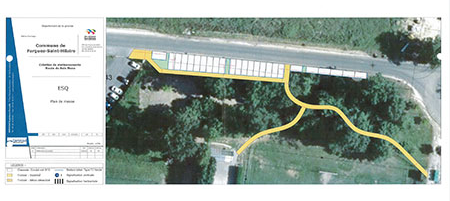
This sector of the town is undergoing major changes with regard to the construction of the bypass and future developments planned on the strip of land located north of the alley of the small wood.
25 spaces will be created in addition to the multimodal area envisaged opposite the underground passage allowing two new bus stops on the future Créon / Place de la République expressway in Bordeaux to be served.
Dejean car park
The planned layout takes into account the need for additional places, as well as the route between the pharmacy and the newly installed medical center.
The asphalt pavement will be used on more than half of the parking lot, the second part will be part of the development of the area currently free of any construction.
The green way
This project is the third part of the path known until then "Mixed way".
Its name has become “Greenway” and will secure the gentle path beyond the hamlet of Cérès towards the places of life located to the south of the 936 road.
Two TransGironde stops will also be installed in order to perpetuate the current provisional stops.
The next stage will resume the development of this greenway towards Beauséjour and Maison Rouge.
The Ad'AP (programmed accessibility agenda) and upgrading
Law n ° 2005-102 of February 11, 2005 for equal rights and opportunities, participation and citizenship of disabled people provides for the risks of incapacity and accessibility of public premises for all disabled people.
The city council voted on June 6, 2016 on a so-called "Ad'Ap" agenda providing for a smoothing of the operation over 6 years and covering all buildings open to the public.
The first part of this operation focused on the dojo, which, after having done some fitting-out work, has just received approval to accommodate people with disabilities.
A budget line is planned to continue the redevelopment of public premises by 2020 and a commission has been appointed by the Mayor to work on it.
The mission of the Accessibility Commission is to ensure that PRM standards (people with reduced mobility, etc.) are applied, in particular in the design of buildings open to the public. This also aims to improve traffic conditions throughout our municipality for all people with reduced mobility, mothers with strollers, the elderly….
We need you to allow us to set up a coherent and exhaustive project of your reality.
Do not hesitate to send us your comments by phone, by email or by post addressed to the town hall.
Telephone: 05.56.21.21.41
Fax: 05.56.68.33.62
Email address: mairie@fargues-saint-hilaire.fr
Postal address: 61 avenue de l'Entre-deux – Mers 33370 Fargues Saint-Hilaire
The accessibility committee thanks you in advance for your civic action.
Sources: http://www.fargues-saint-hilaire.fr/la-commune/projets/parking-du-bois-menu
http://www.fargues-saint-hilaire.fr/la-commune/projets/parking-dejean
http://www.fargues-saint-hilaire.fr/la-commune/projets/voie-verte http://www.fargues-saint-hilaire.fr/la-commune/projets/l-ad-ap-et-la-mise-aux-normes
VIII.Contact information
Fargues-Saint-Hilaire town hall address :
Fargues-Saint-Hilaire town hall
61 avenue de l'Entre-deux-Mers
33370 Fargues-Saint-Hilaire
Mayor : Bertrand Gautier (Mandate : 2014-2020)
Mail: mducasse@fargues-saint-hilaire.fr
Phone number:05 56 21 21 41
Fax: 05 56 68 33 62
Website : http://www.fargues-saint-hilaire.fr
Sources : http://www.cartesfrance.fr/carte-france-ville/33165_Fargues-Saint-Hilaire.html
